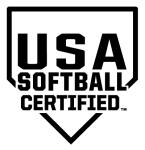- May 29, 2015
- 3,794
- 113
A new year brings a new definition: “damaged bat”. For 2019-2020, NFHS adopted these recommendations made by the rules committee:
Damaged bats are bats that were once legal, but now have become illegal by virtue of damage or use. This includes the traditional “dents, cracks, burs, and rattles” or any other condition that one would consider “broken”. This differentiates the bat’s status from an illegal bat, which is any bat that was never approved with the ASA 2000 or 2004 stamp, was approved but is on the USA Softball banned list, or a bat that has been altered.
The importance of this change is highlighted in the penalty. What was once an out is now a simple removal of the bat from play with no further sanctioning. Should a damaged bat be discovered after it is used to hit a ball into play, umpires should assume the bat was legal and the damage occurred during the at bat.
The new USA Softball stamp will be accepted on legal bats. As USA Softball completes is transition from its previous moniker, the USA Softball Certified stamp will be used on new bats going forward. The 2000 and 2004 ASA stamps are still legal.

Pitchers must have their pivot foot in contact with the pitcher’s plate. Now that sounds silly at face value, however pitchers were previously required to be in contact with the top of the pitcher’s plate before. Now a pitcher may begin with her pivot foot anywhere as long as contact is being made somewhere. All other pitching rules remain the same.
Finally, an update to scoring runs on an appeal play. A run scored will be nullified if the third out of the inning is obtained by a successful appeal on a preceding runner. The previous wording of the rule only applied it to an appeal of a preceding runner missing a base. So what does that mean? If the appeal was for leaving a base early on a fly ball, the run would stand. That is no longer the case.
Play: R3 on third base and R2 on second base with 1 out. B1 hits a fly ball to F8 which is caught. R3 leaves the base before the catch and scores. R2 properly tags up and F8 overthrows the play at third base. R2 scores. The defense properly appeals R3 leaving early for the third out.
Previously the run from R3 would have been nullified by the appeal, but the run scored by R2 would have stood as it was scored before the appealed out. Now both runs will be nullified.
Note: the wording of this rule applies to preceding runners. An appeal play at first base while a runner is attempting to score would still be a timing play.


